From the Alaska Dispatch today comes news that Anchorage’s “friendly snowplows” have helped Anchorage to the top of Livability’s list of the 10 most livable winter cities. The Dispatch quotes Patrick Coleman, CEO of the Winter Cities Institute:
Anchorage public works crews use a ‘friendly snowplow’ that prevents the pushing of snow into residents’ driveways during snow-clearing operations.
Right. Coleman and the Livability people obviously never tried walking on non-downtown Anchorage sidewalks in the wintertime. “Friendly snowplows” in Anchorage — whether belonging to the Municipality of Anchorage or the State of Alaska Department of Transportation — plow all the snow after a big snowfall onto the sidewalks, in huge berms often made worse by icy chunks that make things even more unwalkable for people who walk, ride the bus, etc. — especially for people who have any kind of physical disability. Sometimes sidewalks get cleared, but frequently only weeks after major dumps of snow — if ever. Until then, good luck.
Try walking a few blocks in my winter boots, & see just how “friendly” the snowplows of Anchorage are. Here’s a typical scenario facing any Anchorage pedestrian who walks in places other than downtown or from their doorway to their car:
That’s a photo from Monday, December 5 next to the Sockeye Inn on the north side of Fireweed between C & D streets, looking west. Anchorage residents may remember that we were on the second or third day of some unseasonably warm weather & partial thawing. The sidewalk was barely walkable here, so long as you weren’t old or disabled — full of lumpy chunks of ice thrown up from the road by snowplows on whatever day that most recent snowfall before December 5 had been. And see that hump of snow beyond the light pole? That’s where snow was pushed to clear the Sockeye Inn’s driveway. There’s no pathway for pedestrians at all there, short of climbing the berm.
Why so bad? Because the State of Alaska and Municipality of Anchorage have placed low low priority on making the streets safe for pedestrians, including those who, like me, ride the bus. The Anchorage Daily News reported, also today, on problems with road conditions after recent major dumps of snow — snowfall which occurred after I took the photo above. ADN reports:
The problem appeared to be worse on roads the state maintains — most of the bigger roads in Anchorage, such as Dimond and Northern Lights boulevards, C and A Street and Minnesota Drive. The state also plows the Seward and Glenn highways….
The city plows a few major roads, including Lake Otis Parkway, 36th Avenue and Bragaw Street, and also cleans all the neighborhood streets. Each agency [Municipality of Anchorage and State of Alaska] clears bus stops and sidewalks, too.
Sure. Once in a blue moon. The photo above from December 5 was taken long after the most recent snowfalls. So were these, taken that same evening:
That’s on the west side of C Street just north of Northern Lights, next to the Wells Fargo Bank. This, again, is after the unseaonable warmth & partial thaw earlier in that week — but sidewalks were still a mess because as usual, whoever was responsible had never bothered to plow them. (Along C Street I believe the Alaska Department of Transportation is the (ir)responsible party.) It’s next to impossible to walk on, and definitely impossible if you are old or have a physical disability.
(Julia O’Malley of the Anchorage Daily News wrote an excellent column last January about how lousy the sidewalks are for people in wheelchairs.)
This next one is a few yards further north, by the Wells Fargo parking lot. Already a dangerous area because the drivers of vehicles coming out of that lot tend to crane their necks to the left to look for oncoming cars, seldom checking to the right for oncoming pedestrians.
And a little further to north, approaching Leroy’s Diner. The sidewalk is only marginally better here, but still uneven & poorly maintained. Alaska DOT seems to have decided that it needn’t bother plowing sidewalks if there are parking lots next to them, since parking lots inevitably get plowed by the businesses who own them. Unseen in this photo is that next to this sidewalk is a large vacant lot full of berms that are even more impassible (if that’s possible) than the typical Anchorage wintertime sidewalk.
Here’s one from a few days later, December 8. This is on the north side of Fireweed Lane west of Arctic Boulevard. The sidewalk was so bad that I walked on the street, only using the sidewalk when there was oncoming traffic.
Here’s a couple photos from last February 28, on Northern Lights Boulevard just west of Spenard. Again, snowplows at the last snowfall had thrown a snow berm up onto the sidewalk, and the responsible agency never bothered to clear the sidewalks. Even after the berms began to melt off, pedestrians were left with only a narrow aisle barely wide enough for one person — if she walked partly sideways. Looking east:
Same place, looking west:
None of this is new. Whether it’s the State of the Municipality at fault, Anchorage has had a dismal record of giving a crap for Anchorage pedestrians for years. Here’s the first “lousy winter sidewalks of Anchorage” photo I took on November 20, 2005, on Denali Street next to Sears Mall Carrs. I’m pretty sure this is a Municipality-“maintained” sidewalk.
When it comes to people who walk in the winter, it’s clear: Fairbanks cares more.

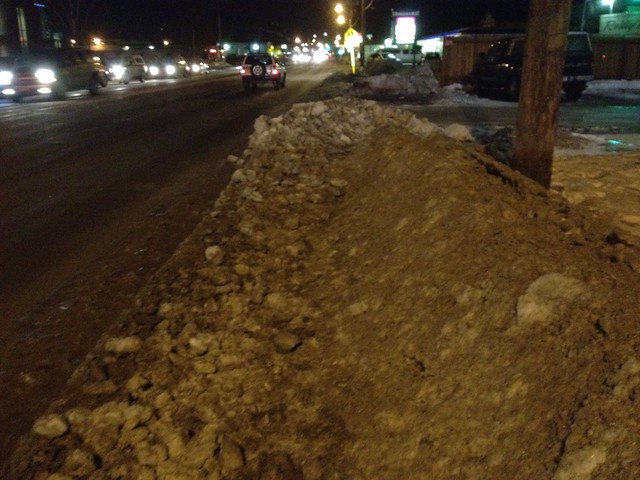
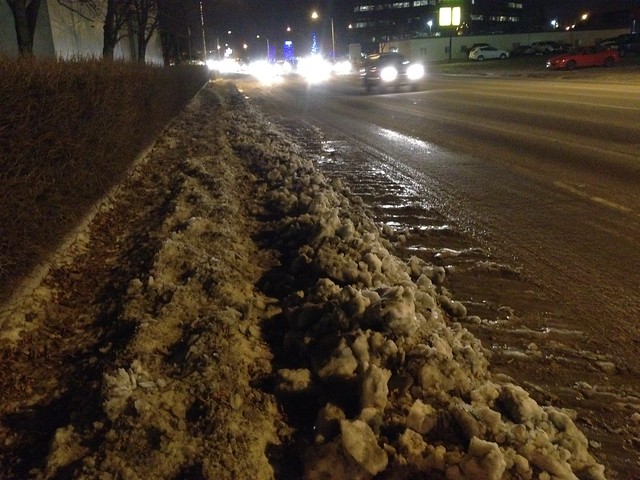
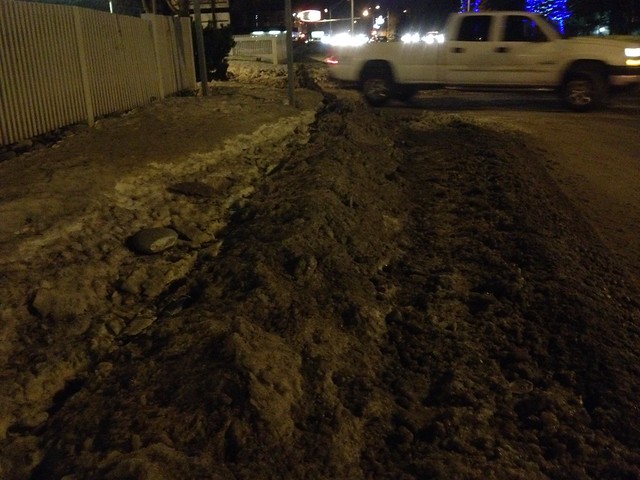
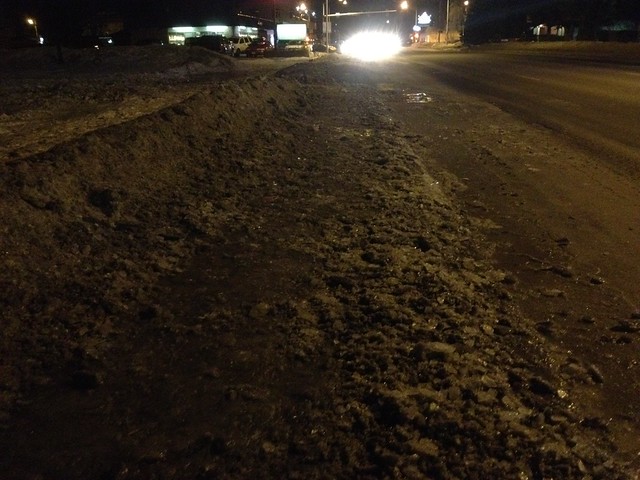
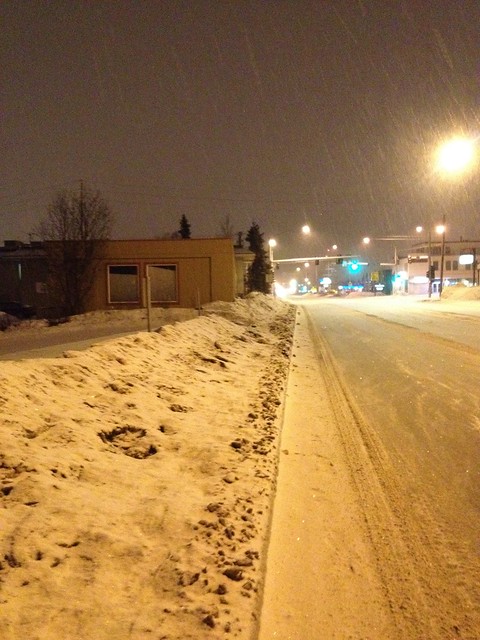

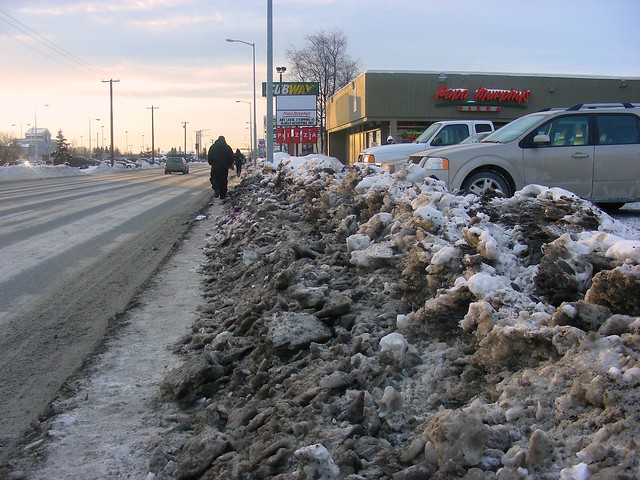
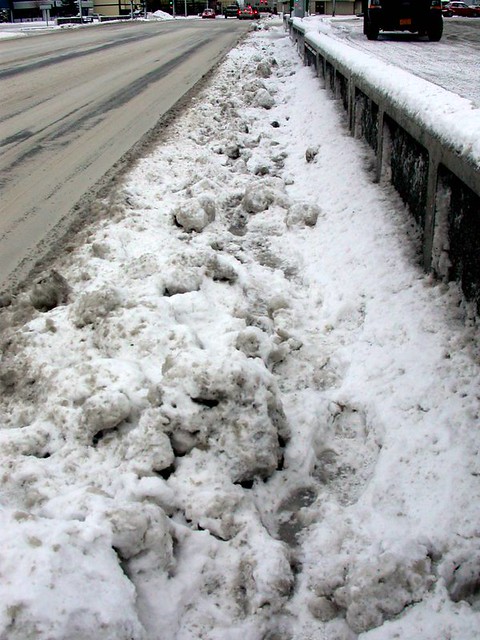
Thank you for this post. We have the same problem in Kenai and Soldotna. Both cities do a pretty good job and no one expects perfection after a big dump of snow, but the highways which are the responsibility of the state just sit for weeks. I got hurt pretty bad last year from a fall due to uncleared sidewalks and when I called to complain I got attitude. I was especially angry that while the sidewalks people needed to walk on to get to grocery stores were not cleared the recreation trails were groomed perfectly. It is very dangerous, especially when it thaws and refreezes and you have to walk on top of it because it is too dangerous to walk in the street.
I watched a guy in a wheelchair wheeling down Arctic today. The lanes for the vehicles are narrow, and the berms are 6 feet high. I nearly lost my balance which would cause me to tumble into the traffic on Northern Lights. At least the lesser traveled side streets are walkable down the middle of the road. I miss the bus no matter what route I take. Walking one block in Anchorage is harder than crossing a frozen lake with 2 feet of snow on it!